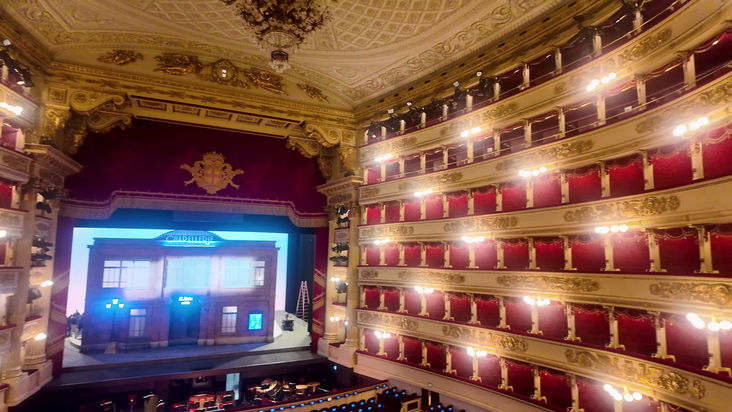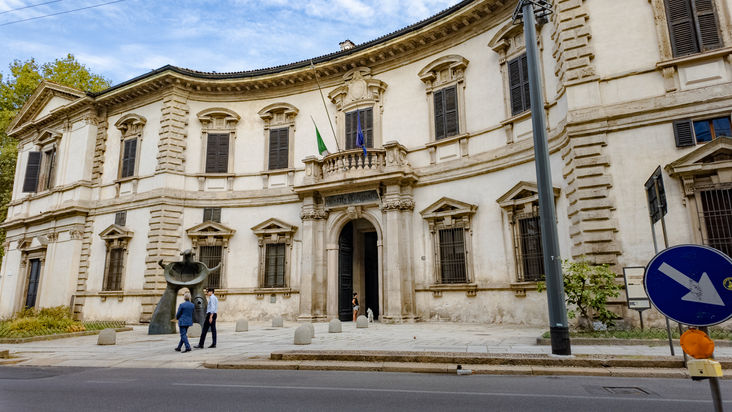top of page



Selfies in front of the Duomo, Milan
Marcia left, Susan right


The Duomo close


The Duomo closer


The Duomo closest


Setting sun behind the Duomo.


Piazza del Duomo ("Cathedral Square")
is the main piazza (city square) of Milan, Italy.
The piazza marks the center of the city, both in a geographic sense
and because of its importance from an artistic, cultural, and social point of view.
and because of its importance from an artistic, cultural, and social point of view.


Equestrian Monument to Vittorio Emanuele II, 1896,
Ercole Rosa, Piazza del Duomo.
The King is shown leading his troops into battle during Italy’s Second War of Independence (1859).


Piazza del Duomo ("Cathedral Square")
is the main piazza (city square) of Milan, Italy.
It is named after, and dominated by, Milan Cathedral (the Duomo).
The piazza marks the center of the city, both in a geographic sense and because of its importance from an artistic, cultural, and social point of view. Rectangular in shape, with an overall area of 17,000 m2 (about 183,000 sq ft), the piazza includes some of the most important buildings of Milan (and Italy in general), as well some of the most prestigious commercial activities, and it is by far the foremost tourist attraction of the city.
The piazza marks the center of the city, both in a geographic sense and because of its importance from an artistic, cultural, and social point of view. Rectangular in shape, with an overall area of 17,000 m2 (about 183,000 sq ft), the piazza includes some of the most important buildings of Milan (and Italy in general), as well some of the most prestigious commercial activities, and it is by far the foremost tourist attraction of the city.


Statue of Victor Emmanuel II in Cathedral Square
In 1896 an impressive monument was installed at the center of the Piazza del Duomo
in honor of Vittorio Emanuele II (Victor Emmanuel II), who in 1861 became the first king of Italy
in honor of Vittorio Emanuele II (Victor Emmanuel II), who in 1861 became the first king of Italy


A street with a cathedral in Milan
Milan, Italy has many streets and squares near cathedrals,
including Piazza del Duomo, which is home to the Duomo di Milano
including Piazza del Duomo, which is home to the Duomo di Milano


The Royal Palace of Milan (Italian: Palazzo Reale di Milano).
The palace was the seat of government in the Italian city of Milan for many centuries.
Today, it serves as a cultural centre and it is home to international art exhibitions.
Today, it serves as a cultural centre and it is home to international art exhibitions.


The Plaza entrance to the Galleria Vittorio Emanuele II.


First inside view of the Galleria.
It is Italy's oldest active shopping gallery and a major landmark of Milan.
The Galleria is named after Victor Emmanuel II, the first king of the Kingdom of Italy. It was designed in 1861 and built by architect Giuseppe Mengoni between 1865 and 1877.
The Galleria is named after Victor Emmanuel II, the first king of the Kingdom of Italy. It was designed in 1861 and built by architect Giuseppe Mengoni between 1865 and 1877.


The Glass dome in the Galleria.
The central octagonal space is topped with a glass dome.


The Galleria is often nicknamed il salotto di Milano (Milan's drawing room).
This is due to its numerous shops and importance as a common Milanese meeting and dining place.


The central octagonal space is topped with a glass dome.
The Milanese Galleria was larger in scale than its predecessors and was an important step in the evolution of the modern glazed and enclosed shopping mall, of which it was the direct progenitor.


Tradition says that if a person spins around three times with a heel on the testicles of the bull from Turin coat of arms this will bring good luck. This practice causes damage to the mosaic: a hole developed on the place of the bull's genitals.
This practice causes damage to the mosaic: a hole developed on the place of the bull's genitals.


The Milan gallery and the roof were unprecedented in dimensions by previously built shopping arcades.
The roof that we see today has gone through different historic modifications and represents complicated conservation issues.[27] In 2015, in preparation for Expo Milano 2015, the facades, statues, and mosaics underwent detailed cleaning and repair, using a giant moving crane scaffolding system.


La Scala, officially Teatro alla Scala, is a historic opera house in Milan, Italy. The theatre was inaugurated on 3 August 1778.
Marcia is climbing the stairs accessible from the theatre's foyer and a part of the house, contains a collection of paintings, drafts, statues, costumes, and other documents regarding the history of La Scala and of opera in general.


La Scala also hosts the Accademia d'Arti e Mestieri dello Spettacolo (Academy for the Performing Arts).
Its goal is to train a new generation of young musicians, technical staff, and dancers.


A sensational re-opening.
In 1943, during World War II, La Scala was severely damaged by bombing. It was rebuilt and reopened on 11 May 1946, with a memorable concert conducted by Toscanini and featuring a soprano solo by Renata Tebaldi (pictured) which created a sensation.


The theatre underwent a major renovation from early 2002 to late 2004.


The stage was entirely rebuilt, and an enlarged backstage allows more sets to be stored, permitting more productions.


Seats now include monitors for the electronic libretto system provided by Radio Marconi
The electronic libretto system now allows audiences to follow opera libretti in English and Italian in addition to the original language.


The theatre has more than 3000 seats.
The theatre is organized into 678 pit-stalls, arranged in six tiers of boxes above which is the 'loggione' or two galleries.





Entrance to the Castle
The courtyard in front of the castle, ready for the wedding celebration.













































Entrance to the Castle
The courtyard in front of the castle, ready for the wedding celebration.










































bottom of page


